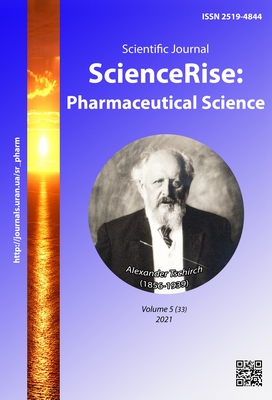The effect of fluoxetine and imipramine on the improvement of depressive-like behaviors and HPA axis (hypothalamic-pituitary-adrenal cortex) activity – an animal model
DOI:
https://doi.org/10.15587/2519-4852.2021.243526Ключові слова:
depressive-like behaviors, HPA axis, fluoxetine, imipramine, animal modelАнотація
Депресія є одним з найпоширеніших психічних розладів, і для зменшення психотичних симптомів використовуються численні ліки.
Метою цього дослідження була оцінка терапевтичних ефектів двох широко використовуваних антидепресантів, включаючи флуоксетин (Flx) та іміпрамін (IMP), для покращення депресивної поведінки, а також активності гіпоталамо-гіпофізарно-надниркової кори (HPA).
Методи: Спочатку для цього експериментального дослідження було відібрано 40 дорослих самців щурів-альбіносів вагою 25±5 г. Тварин утримували в окремих клітках при стандартній температурі (25±1°C) та умовах світло-темря (12-годинний цикл світло/темрява). Щури були розділені на чотири групи: кожна група містила 10 щурів, контрольну групу, група іммобілізаційного стресу, група, що отримувала Flx та група, що отримувала IMP. Поліетиленовий фіксатор використовувався для створення іммобілізаційного стресу протягом 14 днів. Нарешті, параметри IMT, ST, сироваткові рівні кортикостерону та глюкози оцінювали у всіх чотирьох зазначених групах.
Результати: Результати показали, що час нерухомості (IMT) у групі пацієнтів збільшився порівняно з контрольною групою, але час плавання (ST) у групі пацієнтів зменшився порівняно з контрольною групою. Вплив іммобілізаційного стресу на фактори IMT, ST, кортикостерон та глюкози у групі пацієнтів збільшувався та зменшувався відповідно, тоді як вплив препарату Flx на ці фактори зменшувався, збільшувався та посилювався, відповідно, тоді як вплив IMP на всі згадані фактори відповідно зменшувався та посилювався.
Висновок: Грунтуючись на отриманих результатах можна зробити висновок, що антидепресанти Flx та IMP мають різний вплив на активність HPA, а застосування іммобілізаційного стресу викликає депресивну поведінку. Крім того, Flx більш ефективний, ніж IMP, у лікуванні депресивної поведінки
Посилання
- Doron, R., Lotan, D., Einat, N., Yaffe, R., Winer, A., Marom, I. et. al. (2014). A novel herbal treatment reduces depressive-like behaviors and increases BDNF levels in the brain of stressed mice. Life Sciences, 94 (2), 151–157. doi: http://doi.org/10.1016/j.lfs.2013.10.025
- Cao, X., Li, L.-P., Wang, Q., Wu, Q., Hu, H.-H., Zhang, M. et. al. (2013). Astrocyte-derived ATP modulates depressive-like behaviors. Nature Medicine, 19 (6), 773–777. doi: http://doi.org/10.1038/nm.3162
- Abildgaard, A., Elfving, B., Hokland, M., Wegener, G., Lund, S. (2017). Probiotic treatment reduces depressive-like behaviour in rats independently of diet. Psychoneuroendocrinology, 79, 40–48. doi: http://doi.org/10.1016/j.psyneuen.2017.02.014
- Norden, D. M., Devine, R., Bicer, S., Jing, R., Reiser, P. J., Wold, L. E. et. al. (2015). Fluoxetine prevents the development of depressive-like behavior in a mouse model of cancer related fatigue. Physiology & Behavior, 140, 230–235. doi: http://doi.org/10.1016/j.physbeh.2014.12.045
- Park, S.-W., Kim, Y.-K., Lee, J.-G., Kim, S.-H., Kim, J.-M., Yoon, J.-S. et. al. (2007). Antidepressant-like effects of the traditional Chinese medicine kami-shoyo-san in rats. Psychiatry and Clinical Neurosciences, 61 (4), 401–406. doi: http://doi.org/10.1111/j.1440-1819.2007.01676.x
- Gałecki, P., Szemraj, J., Bieńkiewicz, M., Zboralski, K., Gałecka, E. (2009). Oxidative stress parameters after combined fluoxetine and acetylsalicylic acid therapy in depressive patients. Human Psychopharmacology: Clinical and Experimental, 24 (4), 277–286. doi: http://doi.org/10.1002/hup.1014
- Sakr, H. F., Abbas, A. M., Elsamanoudy, A. Z., Ghoneim, F. M. (2015). Effect of fluoxetine and resveratrol on testicular functions and oxidative stress in a rat model of chronic mild stress-induced depression. Journal of Physiology and Pharmacology, 66 (4), 515–527.
- Salmon, E. (2007). A review of the literature on neuroimaging of serotoninergic function in Alzheimer’s disease and related disorders. Journal of Neural Transmission, 114 (9), 1179–1185. doi: http://doi.org/10.1007/s00702-007-0636-5
- Shah, S. K., Dangre, S. C., Charbe, N. B. (2012). Development of RP-HPLC Method for Simultaneous Estimation of Alprazolam and Fluoxetine Hydrochloride in Pharmaceutical Tablet Dosage Form. Research Journal of Pharmacy and Technology, 5 (7), 938–941.
- Cowen, P. (2008). Serotonin and depression: pathophysiological mechanism or marketing myth? Trends in Pharmacological Sciences, 29 (9), 433–436. doi: http://doi.org/10.1016/j.tips.2008.05.004
- Hellweg, R., Zueger, M., Fink, K., Hörtnagl, H., Gass, P. (2007). Olfactory bulbectomy in mice leads to increased BDNF levels and decreased serotonin turnover in depression-related brain areas. Neurobiology of Disease, 25 (1), 1–7. doi: http://doi.org/10.1016/j.nbd.2006.07.017
- Benfield, P., Heel, R. C., Lewis, S. P. (1986). Fluoxetine. Drugs, 32 (6), 481–508. doi: http://doi.org/10.2165/00003495-198632060-00002
- Dixit, N., Trivedi, A., Ahirwar, D. (2020). Synthesis of Citosan Nanocarrier Systems for Improving SSRI-Fluoxetine Efficacy in MDD. Research Journal of Pharmacy and Technology, 13 (5), 2387. doi: http://doi.org/10.5958/0974-360x.2020.00429.1
- Zarrindast, M. R., Shamsi, T., Azarmina, P., Rostami, P., Shafaghi, B. (2004). GABAergic system and imipramine-induced impairment of memory retention in rats. European Neuropsychopharmacology, 14 (1), 59–64. doi: http://doi.org/10.1016/s0924-977x(03)00068-3
- Akhondzadeh, S., Fallah-Pour, H., Afkham, K., Jamshidi, A.-H., Khalighi-Cigaroudi, F. (2004). Comparison of Crocus sativus L. and imipramine in the treatment of mild to moderate depression: A pilot double-blind randomized trial [ISRCTN45683816]. BMC Complementary and Alternative Medicine, 4 (1). doi: http://doi.org/10.1186/1472-6882-4-12
- Chen, Y.-C., Shen, Y.-C., Hung, Y.-J., Chao-Ha, C., Yeh, C.-B., Perng, C.-H. (2007). Comparisons of glucose–insulin homeostasis following maprotiline and fluoxetine treatment in depressed males. Journal of Affective Disorders, 103 (1-3), 257–261. doi: http://doi.org/10.1016/j.jad.2007.01.023
- Hajrasouliha, S., Khakpour, S. (2020). Comparison of antidepressant effect of Melissa officinalis L. hydroalcoholic extract with fluoxetine in male mice. Medical Science Journal of Islamic Azad Univesity-Tehran Medical Branch, 30 (4), 418–424. doi: http://doi.org/10.29252/iau.30.4.418
- Shafei, Z., Abbasi Maleki, S., Ghaderi-Pakdel, F. (2018). Evaluation of the antidepressant-like effect of Viola odorata hydroalcoholic extract in male mice. Journal of Birjand University of Medical Sciences, 25 (4), 286–296.
- Bayramlou, R., Mohammadzadeh, M., Babaei Balderlou, F. (2018). A Comparative Survey of the Effects of Fluoxetine and Imipramine on Depression-Like Behavior and Serum Levels of Corticosterone and Glucose in Male Rats under Immobilization Stress. Qom University of Medical Sciences Journal, 12 (2), 1–10. doi: http://doi.org/10.29252/qums.12.2.1
- Wang, W., Hu, X., Zhao, Z., Liu, P., Hu, Y., Zhou, J. et. al. (2008). Antidepressant-like effects of liquiritin and isoliquiritin from Glycyrrhiza uralensis in the forced swimming test and tail suspension test in mice. Progress in Neuro-Psychopharmacology and Biological Psychiatry, 32 (5), 1179–1184. doi: http://doi.org/10.1016/j.pnpbp.2007.12.021
- Dias Elpo Zomkowski, A., Oscar Rosa, A., Lin, J., Santos, A. R. S., Batista Calixto, J., Lúcia Severo Rodrigues, A. (2004). Evidence for serotonin receptor subtypes involvement in agmatine antidepressant like-effect in the mouse forced swimming test. Brain Research, 1023 (2), 253–263. doi: http://doi.org/10.1016/j.brainres.2004.07.041
- Mitic, M., Simic, I., Djordjevic, J., Radojcic, M. B., Adzic, M. (2013). Gender-specific effects of fluoxetine on hippocampal glucocorticoid receptor phosphorylation and behavior in chronically stressed rats. Neuropharmacology, 70, 100–111. doi: http://doi.org/10.1016/j.neuropharm.2012.12.012
- Roghani, M., Arbab-Soleymani, S. (2013). The Effect of Oral Feeding of Tribulus Terrestris Fruit on Some Markers of Oxidative Stress in the Brain of Diabetic Rats. SSU_Journals, 21 (2), 127–135.
- Pytka, K., Podkowa, K., Rapacz, A., Podkowa, A., Żmudzka, E., Olczyk, A. et. al. (2016). The role of serotonergic, adrenergic and dopaminergic receptors in antidepressant-like effect. Pharmacological Reports, 68 (2), 263–274. doi: http://doi.org/10.1016/j.pharep.2015.08.007
- Liu, L., Zhou, X., Zhang, Y., Liu, Y., Yang, L., Pu, J. et. al. (2016). The identification of metabolic disturbances in the prefrontal cortex of the chronic restraint stress rat model of depression. Behavioural Brain Research, 305, 148–156. doi: http://doi.org/10.1016/j.bbr.2016.03.005
- Yoon, S. H., Kim, B.-H., Ye, S.-K., Kim, M.-H. (2014). Chronic Non-Social Stress Affects Depressive Behaviors But Not Anxiety in Mice. The Korean Journal of Physiology & Pharmacology, 18 (3), 263. doi: http://doi.org/10.4196/kjpp.2014.18.3.263
- Parihar, V. K., Hattiangady, B., Kuruba, R., Shuai, B., Shetty, A. K. (2009). Predictable chronic mild stress improves mood, hippocampal neurogenesis and memory. Molecular Psychiatry, 16 (2), 171–183. doi: http://doi.org/10.1038/mp.2009.130
- Buynitsky, T., Mostofsky, D. I. (2009). Restraint stress in biobehavioral research: Recent developments. Neuroscience & Biobehavioral Reviews, 33 (7), 1089–1098. doi: http://doi.org/10.1016/j.neubiorev.2009.05.004
- Safari, H., Miladi Gorji, H. (2013). Anxiety-like behavior profile in morphine dependent rats exposed to acute and chronic stress. Tehran University Medical Journal, 709–716.
- Sirisha, G., Prakash, R. A., Usha, N. S. (2014). Evaluation of antidepressant effect of chronic administration of tramadol alone and in combination with fluoxetine in low doses in albino mice. International Journal of Pharmacy and Pharmaceutical Sciences, 6 (6), 101–105.
- Nagasawa, M., Otsuka, T., Yasuo, S., Furuse, M. (2015). Chronic imipramine treatment differentially alters the brain and plasma amino acid metabolism in Wistar and Wistar Kyoto rats. European Journal of Pharmacology, 762, 127–135. doi: http://doi.org/10.1016/j.ejphar.2015.05.043
- Heidari, M. (2014). The effect of interference of morphine and immobility stress on performance of pituitary–adrenal axis in mature male rats. Hormozgan Medical Journal, 18 (1), 11–20.
- Heidari Oranjaghi, N., Ghasemi, E., Mahdipour, H., Salehi, B., Sofiabadi, M., Erami, E., Azhdari Zarmehri, H. (2012). Effects of acute and chronic immobilization stress on formalin test on the male rat. Journal of Rafsanjan University of Medical Sciences, 11 (4), 391–402.
- Fagerholm, V., Haaparanta, M., Scheinin, M. (2011). α2-Adrenoceptor Regulation of Blood Glucose Homeostasis. Basic & Clinical Pharmacology & Toxicology, 108 (6), 365–370. doi: http://doi.org/10.1111/j.1742-7843.2011.00699.x
- Hashemi, S. S., Jelodar, G. A., Rafati, A. (2014). Investigating the effects of fluoxetine on cortisol and thyroid hormone levels in rats. Journal of Arak University of Medical Sciences, 17 (2), 82–89.
- Frost, P., Bornstein, S., Ehrhart-Bornstein, M., O’Kirwan, F., Hutson, C., Heber, D. et. al. (2003). The Prototypic Antidepressant Drug, Imipramine, but not Hypericum perforatum (St. John’s Wort), Reduces HPA-Axis Function in the Rat. Hormone and Metabolic Research, 35 (10), 602–606. doi: http://doi.org/10.1055/s-2003-43507
- Heydendael, W., Jacobson, L. (2010). Widespread hypothalamic-pituitary-adrenocortical axis-relevant and mood-relevant effects of chronic fluoxetine treatment on glucocorticoid receptor gene expression in mice. European Journal of Neuroscience, 31 (5), 892–902. doi: http://doi.org/10.1111/j.1460-9568.2010.07131.x
- Bambauer, K. Z., Soumerai, S. B., Adams, A. S., Mah, C., Zhang, F., McLaughlin, T. J. (2004). Does Antidepressant Adherence Have an Effect on Glycemic Control among Diabetic Antidepressant Users? The International Journal of Psychiatry in Medicine, 34 (4), 291–304. doi: http://doi.org/10.2190/kkgw-y42p-baab-jdj0
- McIntyre, R. S., Soczynska, J. K., Konarski, J. Z., Kennedy, S. H. (2005). The effect of antidepressants on glucose homeostasis and insulin sensitivity: synthesis and mechanisms. Expert Opinion on Drug Safety, 5 (1), 157–168. doi: http://doi.org/10.1517/14740338.5.1.157
- Carvalho, F., Barros, D., Silva, J., Rezende, E., Soares, M., Fregoneze, J., De Castro e Silva, E. (2004). Hyperglycemia induced by acute central fluoxetine administration: role of the central CRH system and 5-HT3 receptors. Neuropeptides, 38 (2-3), 98–105. doi: http://doi.org/10.1016/j.npep.2004.04.004
- Khoza, S., Barner, J. C. (2011). Glucose dysregulation associated with antidepressant agents: an analysis of 17 published case reports. International Journal of Clinical Pharmacy, 33 (3), 484–492. doi: http://doi.org/10.1007/s11096-011-9507-0
##submission.downloads##
Опубліковано
Як цитувати
Номер
Розділ
Ліцензія
Авторське право (c) 2021 Raghad Abdulsalam Khaleel, Saja Majeed Shareef, Zinah Essam Hameed, Khulood Majid Alsaraf, Maadh Fawzi Nassar

Ця робота ліцензується відповідно до Creative Commons Attribution 4.0 International License.
Наше видання використовує положення про авторські права Creative Commons CC BY для журналів відкритого доступу.









